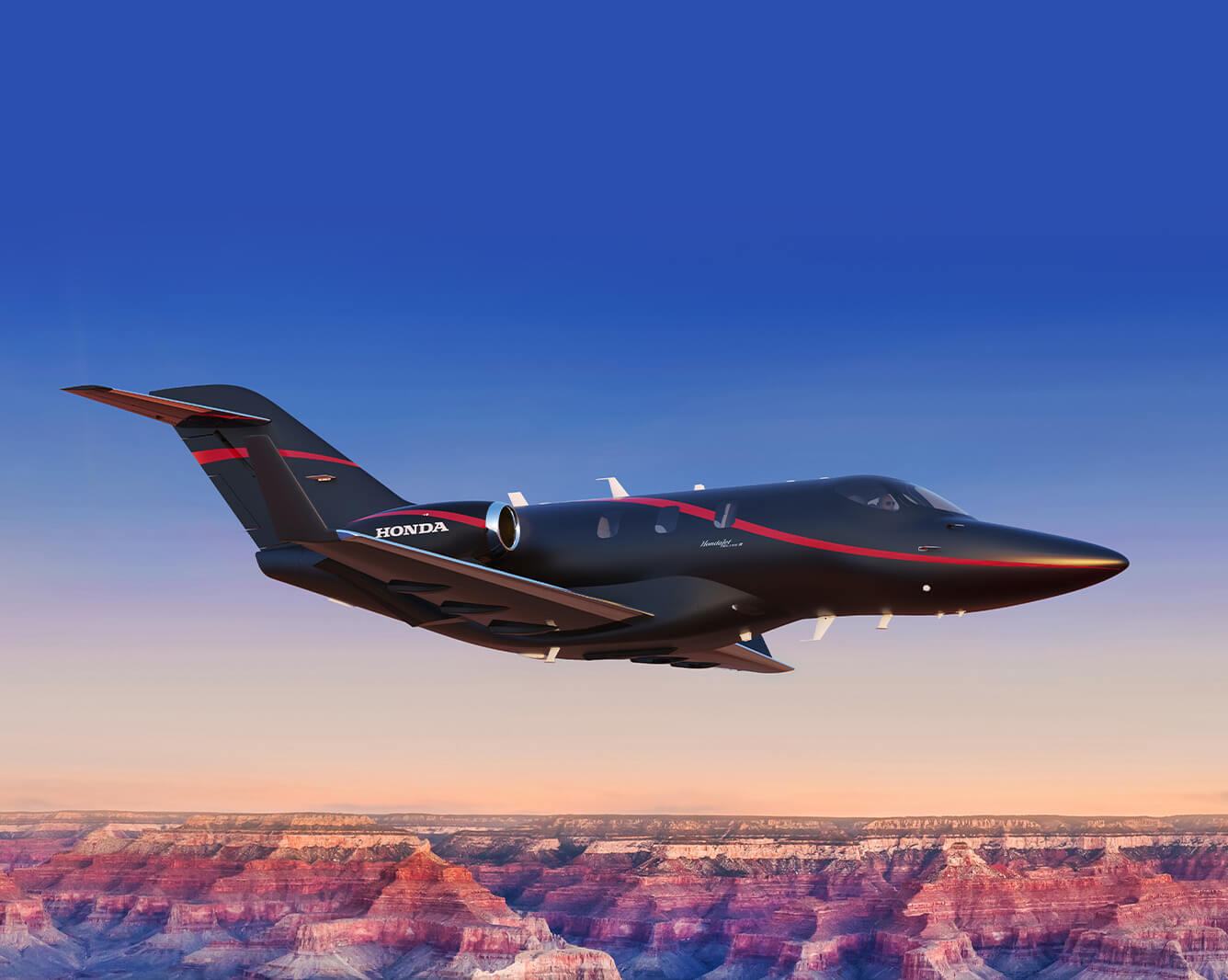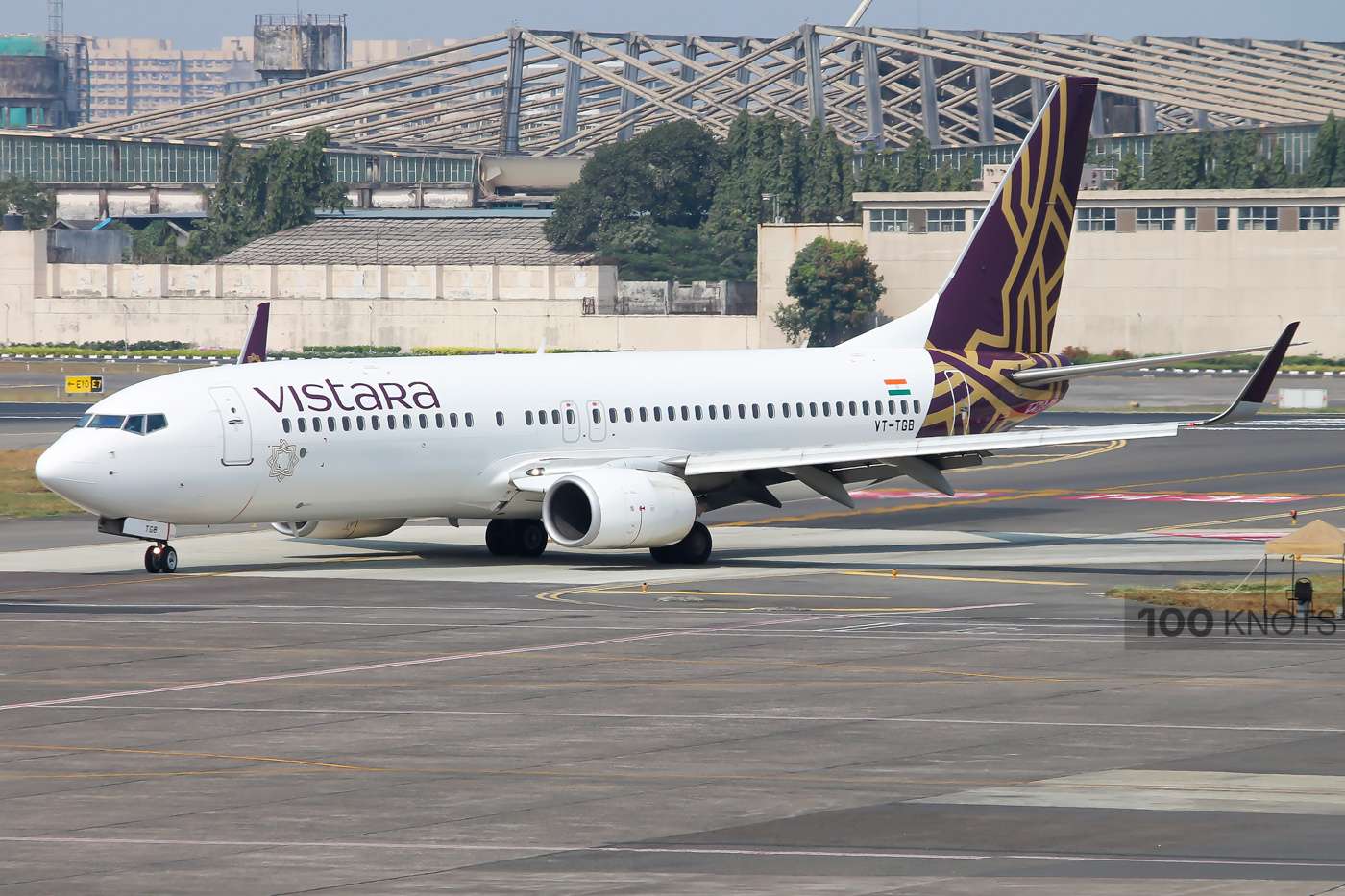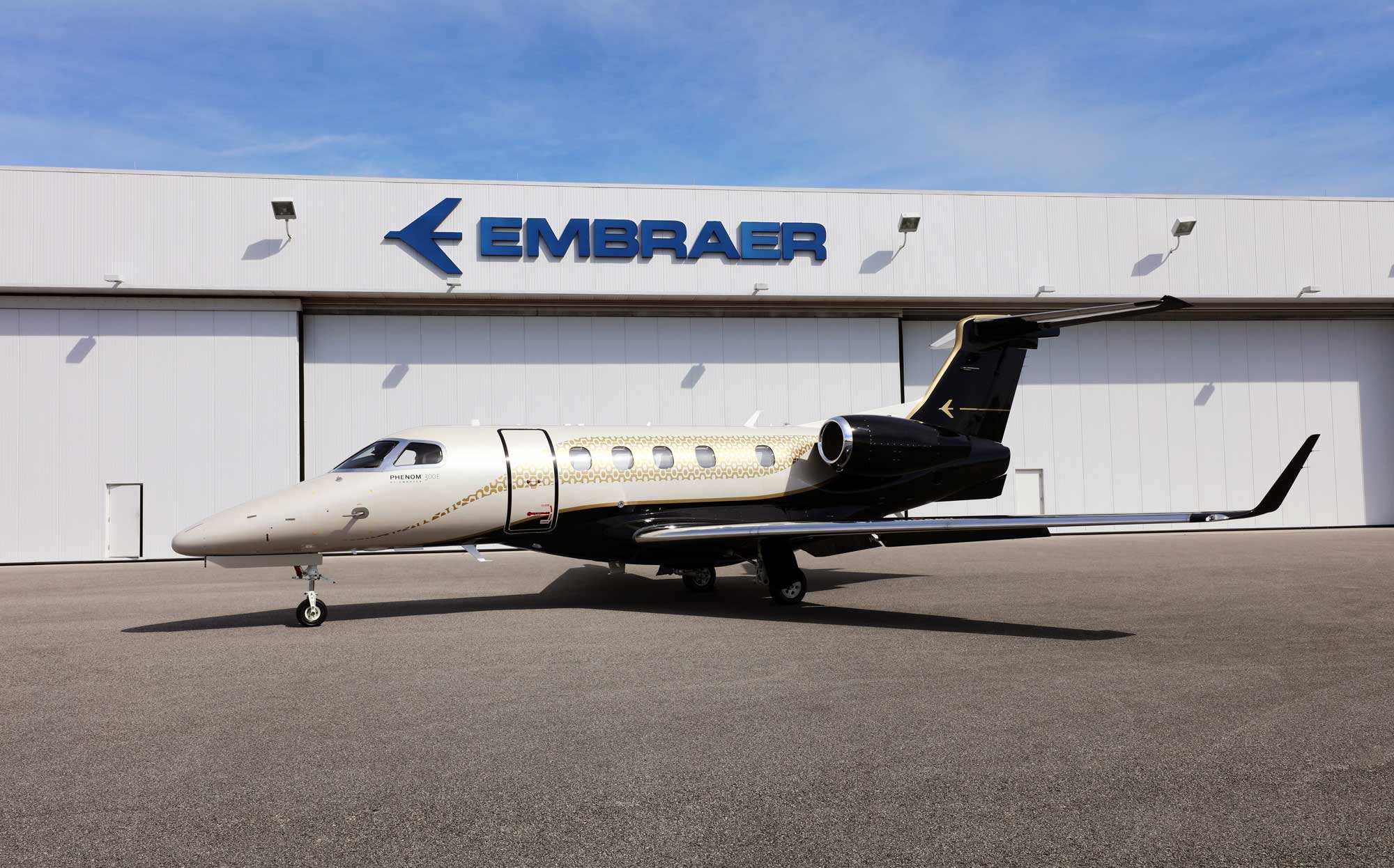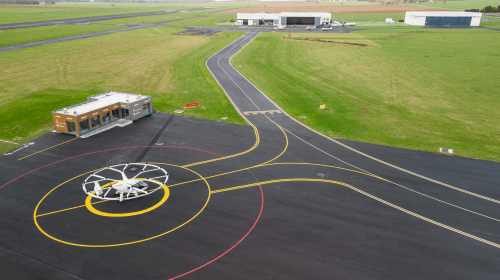The passenger terminal testbed for future electric vertical take-off and landing (eVTOL) is unveiled by Groupe ADP and Skyports at the Pontoise-Cormeilles airport with the assistance of RATP Group, Paris-Région, and the French Civil Aviation Authority (DGAC), which is under the control of the French Ministry of Transports.
The new passenger terminal, which was designed and built by Skyports and Groupe ADP, will serve as a test site for the following passenger services that will be introduced in 2024:
passenger journey: security and check-in processes, passenger dwell time, and aircraft boarding
vehicle integration, ground movement procedures, and charging operations
flight scheduling and passenger information
Passenger terminal of the Vertiport at Pontoise airflied | Group ADP
This passenger terminal serves as a live example of Skyport's efficiency-driven, safety and regulatory compliance approach to AAM infrastructure construction. The vertiport terminal's size, at 115 sq.m., has been carefully assessed to offer enough room to guarantee a comfortable passenger experience with quick throughput while using as little area as feasible. The modular construction makes for a quick and simple build, produces less waste during building, and offers built-in adaptability. Local businesses created and built this terminal, utilizing, whenever feasible, locally available materials.
By 2024, the plan is to create uses for five more vertiports
The logistics, surveillance, and maintenance monitoring, sanitary, and medicinal use cases will all be made easier thanks to the Pontoise testbed.In the medical field, ADP and RATP groups are collaborating with the AP-HP (public assistance hospitals of Paris) to assess the feasibility of a demonstration using light aircraft to meet three transport needs as early as 2024: the transport of biological material, light injuries, or specialized doctors from Paris-Le Bourget, a key health airport for the Paris region.
In Pontoise, we are taking a new decisive step in the development of electric air mobility. The passenger terminal marks the final stage in the development of the Pontoise testbed and the completion of a Volocopter flight fully integrated into the airfield's airspace is the epitome of a year of very ambitious test campaigns. We are now looking ahead to 2024: the development of all uses, sanitary and logistics - Augustin de Romanet, Groupe ADP Chairman and CEO
In order to satisfy the 2024 deadline by providing two lines with passengers between, the abilities established at Pontoise will immediately serve to establish many vertiports throughout the Paris region:
Paris and Versailles (between Paris-Issy-les-Moulineaux heliport and Saint-Cyr l’École airfield)
Paris-Charles de Gaulle and Paris-Le Bourget Airports, and a location in Paris at Quai Austerlitz
The Pontoise-Cormeilles terminal is a physical demonstration of the fact that innovation won’t occur in isolation; it requires collaboration from a multitude of area experts, including operators, vehicle manufacturers, and technology developers, each of which have an important role to play in achieving the ultimate objective of commercial AAM services. With the completion of the terminal, we will now begin comprehensive testing of procedures and technologies in a realistic aviation environment, creating a space for Skyports and consortium partners to accelerate the industry- Duncan Walker, CEO of Skyports
The establishment of these five vertiports is under administrative process. Volocopter is working to get European certification so that its 2X model, which is now the only aircraft authorized by the DGAC for test flights at the Pontoise airfield, can operate at all the aforementioned vertiports.
Group ADP
One of a kind in Europe, the vertiport at Pontoise brings together crucial technical elements for upcoming electric aircraft, such as takeoff and landing zones, passenger terminals, maintenance hangars, and control facilities.
SOURCE: press.groupadp
COVER: Group ADP
Read next
The HondaJet Elite II- the newest aircraft from Honda Aircraft Company is unveiled
Prashant-prabhakar
11 Nov 2022

At the 2022 National Business Aviation Convention and Exhibition (NBAA-BACE), Honda Aircraft Company unveiled the "HondaJet Elite II," a new improved aircraft with a number of significant performance and comfort improvements. The introduction of automation technology was also mentioned by the corporation.
The HondaJet Elite II once again pushes the boundaries of its category on all fronts of performance, comfort, and style. We are also excited to take our aircraft forward on the journey of automation by bringing new technologies to the market next year
said Hideto Yamasaki, President & CEO of Honda Aircraft Company
The HondaJet Elite II
The HondaJet Elite II is the class's fastest, highest, and most maneuverable aircraft. Many of Honda Aircraft's technological advancements are included in the HondaJet Elite II, such as the unusual Over-The-Wing Engine Mount (OTWEM) arrangement, Natural Laminar Flow (NLF) nose and wing, and composite fuselage. The GE Honda Aero Engines HF120 are used to power the aircraft as well. The result is an airplane with the largest cabin in its class with outstanding performance, unmatched efficiency, and maximal fuselage space.
The interior of the HondaJet Elite II has been completely remodeled, and two new interior design options, Onyx and Steel, with new surface materials and colors, have been added. With a comprehensive approach to comfort that includes a nose to tail acoustic treatment, the interior redesign created a contemporary luxury of flying that is peaceful for both passengers and pilots.
Outside, the Elite II debuts a striking new Black Edition paint scheme that further distinguishes the aircraft's ramp appeal.
State-of-the-art avionics
Representative | Hondajet
The Elite II introduces several new advanced features enabling more automation and augmentation, which enhances operational safety and reduces pilot workload for more efficient operations while bringing new technologies to HondaJet customers. The Elite II builds on the highly customized HondaJet avionics suite based on the Garmin® G3000:
Stabilized approach: helps the pilot maintain a steady aircraft state during
Autothrottle: decreases pilot effort by automating power management based on desired flying characteristics during all phases of flight, enabling the aircraft to operate with greater accuracy and efficiency (available 2023)
Emergency Autoland: In an emergency, Garmin Autoland activates to control and safely land the aircraft without human assistance (available 2023)
Hondajet
Performance
Range1,547 nautical milesNew Ground Spoileroptimize takeoff and landing field performance with increased weightMaximum Cruise Speed422 KTAS (782 km/h)Hondajet
Honda Aircraft Company has announced its journey toward automation and expects to roll out Autothrottle and Emergency Autoland by the end of 2023. This direction encapsulates the ongoing work to enhance operational safety and decrease pilot workload while connecting with worldwide Honda's commitment to safety technology advancements in the HondaJet through automation, augmentation, and situational awareness technologies.
Representative | Hondajet
Although the US is Honda Aircraft's largest market, its sales and service network is international. The US (FAA), Europe (EASA), Mexico (AFAC), Brazil (ANAC), Argentina (ANAC), Panama (AAC), India (DGCA), Japan (JCAB), Canada (TCCA), China (CAAC), Turkey (DGCA), Pakistan (PCAA), Russia (FATA), and Thailand (CAAT) are among the 14 countries in which HondaJet has achieved type certification.
SOURCE: HONDAJET
COVER: HONDAJET
Read next
Vistara adds new flights to Frankfurt and Paris on its new B787 Dreamliner
Radhika Bansal
11 Nov 2022

Vistara has increased frequencies to Frankfurt and Paris starting Thursday, November 10. The carrier will now operate six weekly flights between Delhi and Frankfurt, and five weekly flights between Delhi and Paris. Vistara has added these flights as its third Boeing 787-9 Dreamliner joined its fleet recently, following customisation of the leased aircraft.
Vistara’s third Boeing 787-9 Dreamliner comes with a three-class cabin configuration, with 30 seats in Business Class, 36 in Premium Economy and 226 seats in Economy Class. The new aircraft will also feature fully-flat business-class seats, each with direct aisle access.
https://twitter.com/airvistara/status/1587814372940058625
Flights between Delhi’s Indira Gandhi International Airport and Paris Charles De Gaulle will take off five times a week, with frequencies on Monday, Wednesday, Friday, Saturday, and Sunday.
Vistara’s Delhi-Frankfurt route will run six times a week, doubling its current capacity, with flights offered on Monday, Tuesday, Thursday, Friday, Saturday, and Sunday. The carrier advises that the arrival and departure times are currently a guide, subject to approval by Frankfurt Airport.
Flight No.RouteDepartureArrivalUK0021DELHI (DEL) – PARIS (CDG)1345 Hrs IST1840 Hrs CETUK0022PARIS (CDG) – DELHI (DEL)2145 Hrs CET1030 Hrs (+1) ISTUK0025DELHI (DEL) – FRANKFURT (FRA)1355 Hrs IST1845 Hrs CETUK0026FRANKFURT (FRA) – DELHI (DEL)2140 Hrs CET1020 Hrs ISTFLIGHT SCHEDULE
A host of other features in all three cabins are thoughtfully put together to reflect Vistara’s focus on delivering an unparalleled flying experience. These include in-seat screens in all three cabins with High Definition (HD) Displays offering a cutting-edge In-flight Entertainment system powered by Panasonic.
"Europe has been a key focus market for us since the very beginning, and we are glad that our customers appreciate our offerings on these long-haul routes. We have been wanting to ramp up frequencies on these sectors and we are delighted to be able to finally do that."
Deepak Rajawat, Chief Commercial Officer, Vistara
ALSO READ - Delayed 787 Delivery makes Vistara to cancel several flights
Vistara has faced some notable setbacks with its 787 orders, owed to a combination of production issues with the Dreamliner program and the COVID-19 pandemic, leaving the carrier with just two of the type delivered. The airline still has an outstanding order for four aircraft, with deliveries expected to resume in 12-18 months.
ALSO READ - Vistara to add new destinations
Vistara has recently added a range of new routes to its rapidly growing network map, including daily flights between Mumbai and Abu Dhabi and a twice-weekly Mumbai-Dhaka service, launched in October and November, respectively.
ALSO READ - Vistara inaugurates daily non-stop flight between Mumbai and Abu Dhabi
Vistara adds new flights to Frankfurt and Paris on its new B787 Dreamliner
Since 2019, the carrier has added 25% more flights, increasing its international offerings from five to 11. While financial losses slowly crept up during the first half of 2022, the carrier has remained positive, citing increased demand and its dense domestic network.
TATA SIA Airlines Limited, known by the brand name Vistara, is a 51:49 joint venture between Tata Sons Private Limited and Singapore Airlines Limited (SIA). The airline has a fleet of 54 aircraft, including 41 Airbus A320, five Airbus A321neo, five Boeing 737-800NG and three Boeing 787-9 Dreamliner aircraft and has flown more than 35 million customers since starting operations.
Read next
Embraer progressing well with India in building a new-generation turboprop aircraft
Radhika Bansal
10 Nov 2022

Embraer has said its discussions with Indian and global companies for building a new generation turboprop aircraft are progressing well. The Brazilian plane maker, which produces both civil and military jets, has been scouting for partners for its proposed aircraft programme, which could include the manufacture of planes as well.
“We are in discussions with potential partners in India and globally on a selection of partnering options for the next generation turboprop aircraft — including manufacturing. These discussions are ongoing and progressing well. The next generation turboprop aircraft is in the development phase and a decision to launch the project has not been made."
Embraer
ALSO READ - Embraer in talks with India for collaboration on its upcoming turboprop aircraft
Embraer shared this project update in the backdrop of Prime Minister Narendra Modi’s recent remarks on how India could become a manufacturing hub for large passenger aircraft. He made the remarks at the inauguration of the Tata-Airbus C-295 aircraft manufacturing facility in Vadodara on October 30.
Embraer has more than 1,700 commercial jets in service globally. In July, it released a 20-year market outlook, estimating global demand for turboprops could touch 2,280 units. Of this, it said, around 960 units could come from the Asia Pacific region.
Embraer predicts the world will need around 11,000 new aircraft with up to 150-seats over the next 20 years. The replacement of ageing aircraft will account for 57% of all new deliveries, while 43% will be used to grow markets.
The plane maker feels that there will be a trend toward smaller aircraft, driven by an increasing need for flexibility, connectivity, and efficiency. And this is where its new generation turboprop (TPNG) comes into the picture.
Embraer Commercial Aviation president and CEO Arjan Meijer said the new aircraft "is not a turboprop as we know it." It is more of an E-Jet E-2 aircraft with a different form of propulsion rather than an improved turboprop. The TPNG will have the same cabin experience as the E2, and moving the engines to the rear will mean a much quieter cabin.
Embraer is looking to launch the project sometime in the middle of next year so that the plane could enter service around 2028.
ALSO READ - Star Air to lease 2 Embraer E175 aircraft from Nordic Aviation Capital
In India, Star Air operates five ERJ145 planes and recently signed an agreement to induct two E175 aircraft.
The E175 is its most popular aircraft and US airline Sky West is the largest operator of these planes, with 230 jets. In India, Star Air operates five ERJ145 planes and recently signed an agreement to induct two E175 aircraft. At present, there are also 22 Embraer-made business jets in the country.
Airbus did not respond to a query on the assembly of planes in India. “Boeing is in a sweet spot to continue delivering on our commitment to Aatmanirbhar Bharat,” the US plane maker said. “Our business and supply chain teams are constantly evaluating opportunities where India can continue to become a more significant part of Boeing’s global supply chain,” it added.
Boeing annually sources around USD 1 billion worth of aircraft parts from its network of over 300 suppliers in India. It, however, manufactures all its passenger planes in the US. It has a completion centre in China where seats are fitted in planes built and flown from the US. Airbus has aircraft assembly lines in China and the US.
“Aircraft production rates have still not recovered to pre-Covid levels. Manufacturing and assembly would require billions of dollars in investment plus certified and skilled manpower. Then there is the question of market size. Manufacturers will not duplicate facilities unless there is a sound business case,” said an aviation industry veteran.
(With Inputs from Business Standard)
Read next
CDB Aviation, a fully owned Irish subsidiary of China Developmental Bank Financial Leasing Co Limited, announced on the sidelines of the Airline Economics Growth Frontiers Asia Pacific 2022 conference. They announced the signing of the lease agreement for a fleet of six Airbus A320neo aircraft with Air India, a statement from the company said.
CDB Aviation is one of the first aircraft leasing brands to secure Air India’s additional A32neo aircraft that falls under the newly announced transformation plan ever since the purchase of the airline by the Tata group. This aims to increase the carrier’s fleet and help to boost its domestic as well as international operations.
Air India leases 6 Airbus A320 NEOs from CDB Aviation
ALSO READ - Air India to revamp its fleet by leasing 30 aircraft in the upcoming months
Amid its aggressive drive for fleet expansion, Air India has recently announced a 15-month plan in which it aims to lease 30 aircraft comprising 5 Boeing B777-300, 21 A320neo and 4 A321neos.
“Our commercial team is delighted to have worked closely with Air India to help solve their fleet requirements with these new Airbus narrowbody aircraft from our orderbook. These fuel-efficient, new generation aircraft are suited well to support Air India’s fleet revitalisation initiatives, positioning the airline for sustained growth and profitability.’’
Ryan Barrett, Asia-Pacific Business Head, Air India
The B777s will join the fleet between December 2022 and March 2023 and will be deployed on routes to the US. The deliveries of the Airbus narrowbodies are expected to be spread across the whole of next year.
ALSO READ - Air India plans to expand its fleet 3 times; in discussions with aircraft manufacturers
“India is an increasingly important region for CDB Aviation, being the second largest Asia Pacific market for new aircraft deliveries, with nearly 1,000 Boeing and Airbus jets in its orderbook. Our commercial team remains steadfast in its outreach efforts across Asia Pacific, leveraging our platform’s resources and scale to support the region’s airlines in restoring their networks and growing their fleets.”
Peter Goodman, Chief Commercial Officer, CDB Aviation
ALSO READ - Air India unveils Vihaan.AI – a comprehensive 5-year transformation plan
Expected to be delivered in the second half of 2023, renewal of the fleet will help Air India to increase its market share to at least 30% in the domestic market while significantly growing international routes from the present market share.
"This is an important agreement, which will help us to strengthen our fleet with state-of-the-art aircraft. This will boost our connectivity, especially on the short and medium-haul routes, and is an important step ahead in our transformation journey."
Nipun Aggarwal, Chief Commercial Officer, Air India
Apart from assets in Aircraft, Tata Group-backed Air India looks to create a talent pool. And the first phase of this initiative has received an overwhelming response. Over 1,752 applications for pilots and 72,000 applications for cabin crew have been received in the last two months, which are in the process of assessment.
Read next
IndiGo to bolster cargo operations by adding another freighter aircraft by year-end
Sakshi Jain
10 Nov 2022
IndiGo will further bolster its cargo operations as it plans to add another aircraft to boost its freight operations, later this year. To take advantage of the cargo market in India, the airline intends to operate a total of four converted A321 planes.
To support its all-cargo operations, IndiGo will take delivery of a second Airbus A321P2F (Passenger To Freighter) aircraft by December. Three more of these aircraft will gradually join the fleet of the carrier over the ensuing months after the first one did so in September.
ALSO READ - IndiGo plans to induct 4 dedicated cargo aircraft
“On our Cargo operations, volumes have been increasing owing to our sheer network presence and we remain optimistic. Cargo “belly" capacity will be further augmented with the introduction of the first Airbus 321 freighter and we are also expecting the second such aircraft to be operational by December.”
Pieter Elbers,CEO, IndiGo
He continued by saying that the airline will benefit financially from having a dedicated cargo fleet in addition to being able to service markets like China, Vietnam, the Middle East, and several CIS (Commonwealth of Independent States) nations.
The A321P2F is a component of Airbus' overall cargo strategy, which is being developed under a programme involving Elbe Flugzeugwerke GmBH, a partnership between Airbus and Singapore's ST Engineering. The cargo capacity of the aircraft, which is approximately double that of a typical A321, is 27 tonnes.
To support its all-cargo operations, IndiGo will take delivery of a second Airbus A321P2F aircraft by December
India is presently in an era of cargo expansion. Data from the Airports Authority of India (AAI) shows that all operational airports handled 3.14 million tonnes of freight in 2021–22, or 94% of the freight handled in 2017–18, while air passenger traffic, at 85.1 million, was 69% of the traffic recorded in FY18. This indicates that the cargo segment in India has fared better than the passenger side.
The country's air cargo business has been impacted by a downturn in exports, but the airlines are optimistic that setting up freight operations over the coming years would result in long-term advantages.
There used to be only one dominant all-cargo player in the nation: Blue Dart. While it currently dominates India's domestic cargo market, new competitors have just entered the race, including IndiGo.
https://twitter.com/PradhaanAir/status/1589623482807353344
ALSO READ - Pradhaan Air Express receives its first converted A320 freighter aircraft
Pradhaan Air, India's newest all-cargo airline, started offering commercial operations last month. The airline now runs the first Airbus A320 freighter to be converted, and another one will be delivered soon.
SpiceJet, an additional low-cost carrier and IndiGo's rival, is attempting to dominate the cargo market with SpiceXpress, a cash-positive business with a $5.6 million nett profit.
SpiceJet, an additional low-cost carrier and IndiGo's rival, is attempting to dominate the cargo market with SpiceXpress
Indian airlines are expanding their cargo capacity as the market has grown into a significant and potential source of income over the past two years. From only 5 to nearly 30 aircraft, India's fleet of exclusively designed freighters has undergone a significant increase in size.




Comment